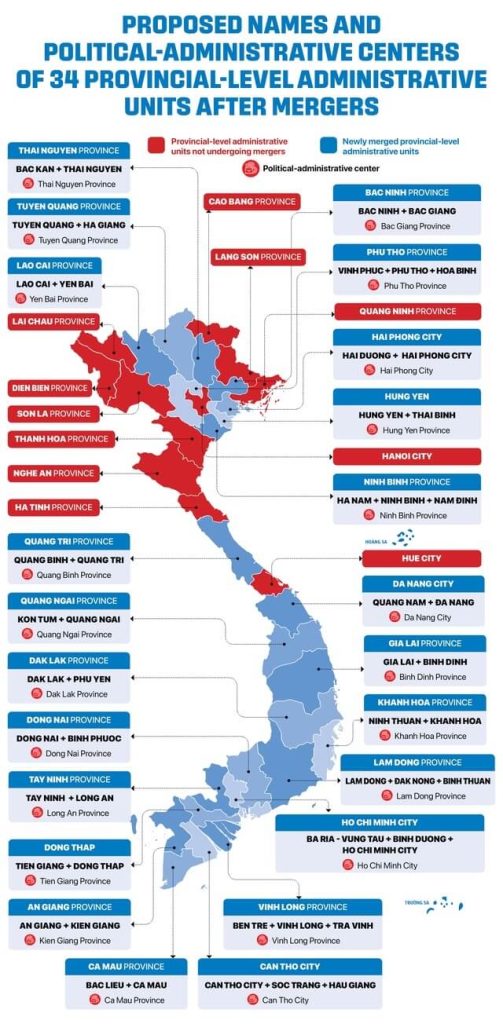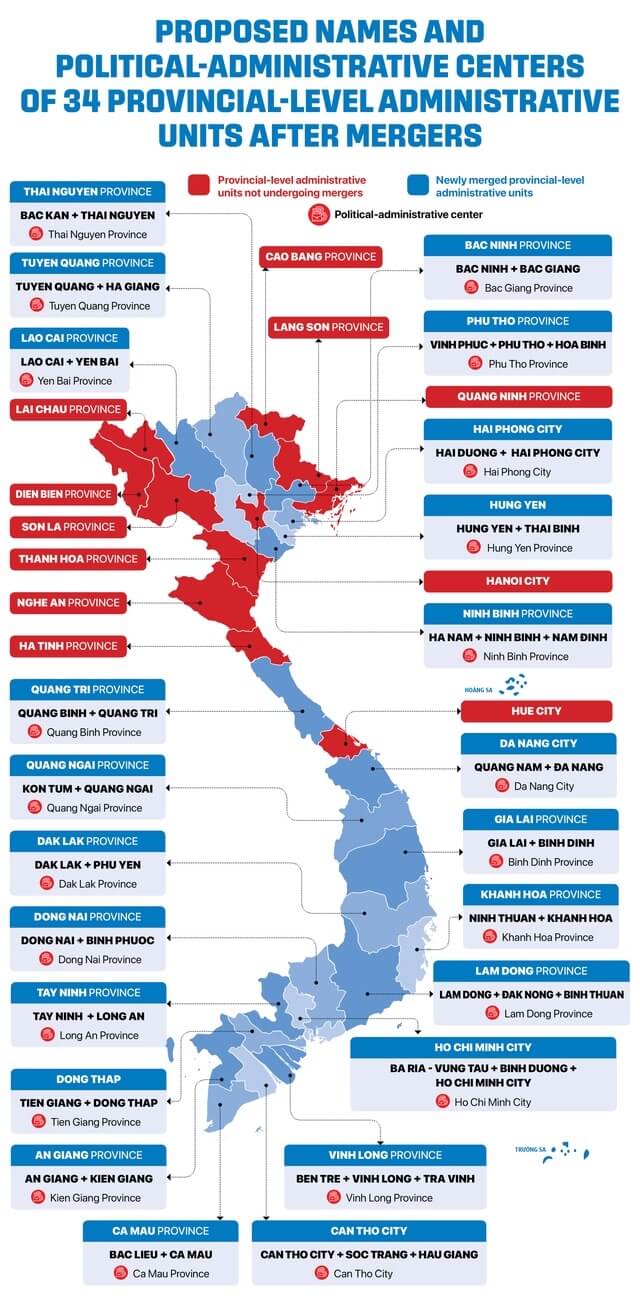Discover how Vietnam Merges Provinces will reshape the country from 63 provinces down to 34, and what that means for travelers. Learn about Vietnam's two-tier governance, key unchanged destinations, and practical tips to navigate your trip with ease. Make your travel effortless with Saigon Local Tour today!
Vietnam Merges Provinces in 2025
Beginning July 1, 2025, Vietnam will officially implement one of its most ambitious administrative reforms: the Vietnam provincial merger. Guided by Resolution No.202/2025/QH15, issued at the 11th plenum of the 13th Party Central Committee under Party General Secretary Tô Lâm, the nation will reduce its 63 provincial-level units to 34, comprising 28 provinces and 6 centrally governed cities.
This bold initiative aims to increase governance efficiency, reduce overlap in local administration, and streamline public services through a two-tiered structure. District-level units will be dissolved entirely, giving way to a leaner governance model.
For travelers, the changes are more than administrative. They create exciting new opportunities to explore larger, more dynamic regions. Whether you're planning a deep dive into Vietnamese heritage or just flying in for a weekend escape, this merger is a game-changer. Don’t forget to enhance your arrival with Fast Track airport services from Saigon Local Tour and avoid the hassle at immigration queues.
Key Milestones of the Vietnam Provincial Merger
- June 12, 2025: National Assembly approves the resolution and legal updates.
- June 30, 2025: New provincial leadership structures are announced and digital maps updated.
- July 1, 2025: Merger comes into effect. District-level administrations are dissolved, and the new governance system is officially adopted.
Vietnam’s careful timeline shows a commitment to a smooth, transparent transition that minimizes disruption for residents and tourists alike.
Understanding the Two-Tier Governance System
Provincial Level (28 Provinces + 6 Centrally Governed Cities)
This upper tier is responsible for strategic matters such as economic planning, transportation, and administrative services including land-use rights and infrastructure development.
Commune Level (Communes, Wards, Townships)
At the grassroots, this level handles community services, basic administrative procedures, and supports local tourism. The number of commune-level units is expected to drop by 60–70% to enhance efficiency.
Elimination of Districts
By removing the district level, Vietnam expects to save approximately $7.3 billion by 2030, accelerating decision-making and service delivery.
✈️ Flying into Ho Chi Minh City soon? Avoid long queues and begin your journey smoothly by booking our Fast Track arrival service.
List of Newly Vietnam Merges Provinces
| Merged Units | New Province/City | New Admin Center |
| Tuyen Quang + Ha Giang | Tuyen Quang | Tuyen Quang City |
| Lao Cai + Yen Bai | Lao Cai | Yen Bai City |
| Bac Kan + Thai Nguyen | Thai Nguyen | Thai Nguyen City |
| Vinh Phuc + Phu Tho + Hoa Binh | Phu Tho | Viet Tri City |
| Bac Ninh + Bac Giang | Bac Ninh | Bac Giang City |
| Hung Yen + Thai Binh | Hung Yen | Hung Yen City |
| Hai Duong + Hai Phong | Hai Phong | Hai Phong City |
| Ha Nam + Ninh Binh + Nam Dinh | Ninh Binh | Ninh Binh City |
| Quang Binh + Quang Tri | Quang Tri | Dong Hoi City |
| Quang Nam + Da Nang | Da Nang | Da Nang City |
| Kon Tum + Quang Ngai | Quang Ngai | Quang Ngai City |
| Gia Lai + Binh Dinh | Gia Lai | Quy Nhon City |
| Ninh Thuan + Khanh Hoa | Khanh Hoa | Nha Trang City |
| Lam Dong + Dak Nong + Binh Thuan | Lam Dong | Da Lat City |
| Dak Lak + Phu Yen | Dak Lak | Buon Ma Thuot City |
| Ba Ria-Vung Tau + Binh Duong + HCMC | Ho Chi Minh City | HCMC |
| Dong Nai + Binh Phuoc | Dong Nai | Bien Hoa City |
| Tay Ninh + Long An | Tay Ninh | Tan An City |
| Can Tho + Soc Trang + Hau Giang | Can Tho | Can Tho City |
| Ben Tre + Vinh Long + Tra Vinh | Vinh Long | Vinh Long City |
| Tien Giang + Dong Thap | Dong Thap | My Tho City |
| Bac Lieu + Ca Mau | Ca Mau | Ca Mau City |
| An Giang + Kien Giang | An Giang | Rach Gia City |
What Vietnam Provinces Stay the Same?
While many areas will undergo change, 11 provinces and cities will remain unchanged:
- Hanoi – Vietnam’s timeless capital
- Hue – Cultural center of imperial history
- Lai Châu, Điện Biên, Sơn La – Remote highlands with rich ethnic traditions
- Cao Bằng, Lạng Sơn – Northern frontier provinces
- Quảng Ninh – Home to Ha Long Bay
- Thanh Hóa, Nghệ An, Hà Tĩnh – Central coastal and historical strongholds
These destinations offer travelers a sense of continuity, with mature infrastructure and well-known tourist offerings.
Why Vietnam Merges Provinces Matters for International Travelers
Streamlined Procedures
With fewer administrative layers, processes such as permits, visa extensions, or travel registrations will be quicker and more centralized.
Better Transportation Links
Merging smaller provinces into larger regions encourages investment in infrastructure, which means smoother roads, better rail, and improved intercity bus routes.
Diverse Experiences in One Region
Newly merged provinces now span coastlines, cities, and mountains—giving tourists more to explore without crossing into different administrative zones.
Stronger Regional Tourism Policies
With economic zones expanding, tourism services such as hotel licensing or guide accreditation will be standardized, creating consistency across destinations.
Frequently Asked Questions About Vietnam Merges Provinces
Q1: What is the Vietnam provincial merger?
A: It is a major reform to consolidate Vietnam's 63 provincial-level units into 34, streamlining governance by removing the district level.
Q2: Which places are not affected by the merger?
A: 11 provincial units including Hanoi, Hue, Quang Ninh, and Nghe An will remain unchanged.
Q3: How does this help tourists?
A: Travelers benefit from fewer administrative steps, better infrastructure, and more regional diversity within single destinations.
Q4: Will this affect visa or entry procedures?
A: No major changes to entry requirements are announced, but processes may become faster due to centralization.
Q5: How can I plan my travel under the new structure?
A: Use updated maps from the Vietnam Department of Survey and consult tour operators like Saigon Local Tour for expert guidance.
Start exploring Vietnam’s new era with Saigon Local Tour! We offer curated experiences and Depature Fast Track Service that ensure every moment of your trip is smooth, exciting, and unforgettable.





